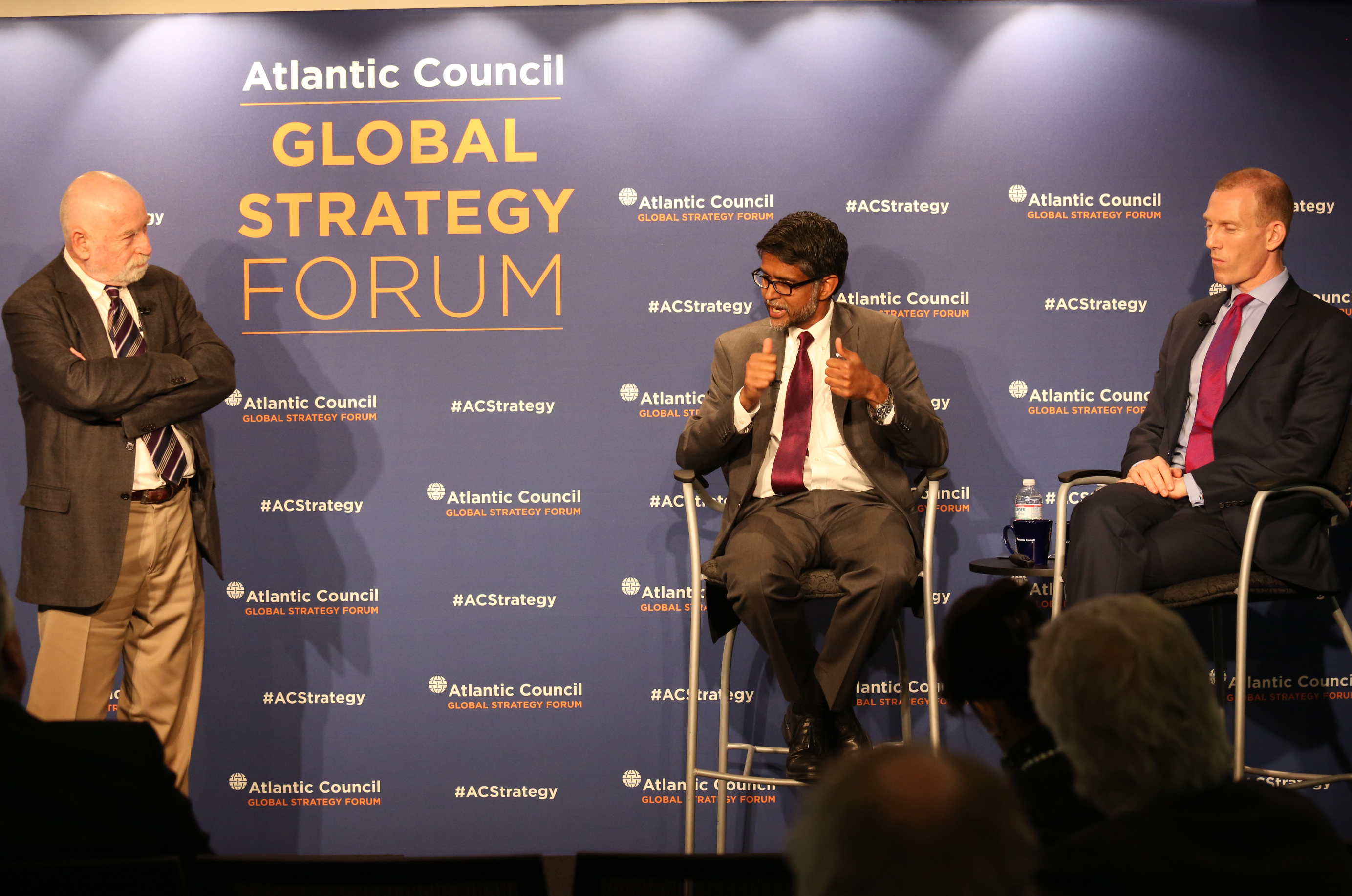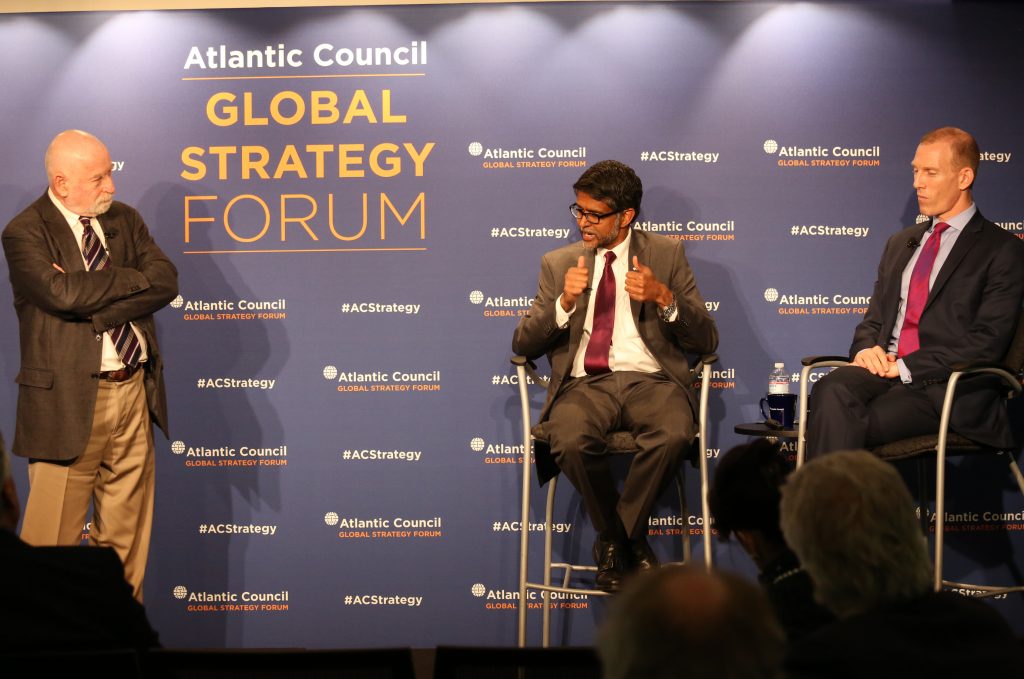 Tiny robots that can predict the exact fruit yield of apple trees while helping farmers cut water usage. Drone swarms which respond to 911 emergency calls without risking human lives. Genetically modified humans free of dozens of diseases that once killed millions.
Tiny robots that can predict the exact fruit yield of apple trees while helping farmers cut water usage. Drone swarms which respond to 911 emergency calls without risking human lives. Genetically modified humans free of dozens of diseases that once killed millions.
Science fiction? Maybe, but not for long, say two scholars who spoke April 29 at the Atlantic Council’s Global Strategy Forum. The two-day event featured Vijay Kumar, UPS Foundation Professor at the University of Pennsylvania, and Jamie Metzl, a Nonresident Fellow at the council’s Brent Scowcroft Center on International Security.
Atlantic Council Chairman Jon M. Huntsman, Jr., said the council—concerned that the United States is being left behind—aims to make the Global Strategy Forum an annual event “intended to stimulate imagination, thinking, and action” in fields such as robotics, biotechnology, and genetic engineering.
“Our government structures and processes are increasingly disconnected from the complexity and actual pace of events,” said Huntsman, former Governor of Utah and former US Ambassador to China. “We need to think innovatively about strategy, rather than look backwards for strategies that may be more familiar to us but less applicable.”
Such an approach is even more critical given what well-known futurist and author Peter Schwartz laments is a lack of US leadership in the face of Chinese advances in science.
“Since the signing of NAFTA [North American Free Trade Agreement], we’ve walked away from every treaty—whether it was about land mines or Law of the Sea,” said Schwartz, Senior Vice President for Government Relations and Strategic Planning at Salesforce.com. “The United States has essentially abandoned the framework of institutions, stepping off the world stage. As a result, the most powerful force for order, stability, and peace has abdicated power in a world of increasing chaos.”
Yet Americans are doing pioneering research in both robotics and biotechnology.
Since 2007, Kumar—a former Assistant Director of Robotics at the White House Office of Science and Technology Policy—has led a team at the University of Pennsylvania that builds drones for civilian, medical, agricultural, and law-enforcement applications.
“Most commercial drones use GPS because that’s how they get information for navigating,” Kumar explained while showing his audience a video demonstrating the technology. “Our drone can function indoors using a system of sensing, which involves cameras on top and laser scanners that allow it to detect features in the atmosphere and triangulate its position. This lets you deploy robots to look around a room without actually entering the room.”
But that drone is heavy, burning about one hundred watts of energy per pound. It costs $20,000 to build from off-the-shelf components and can operate up to only ten minutes.
To circumvent those restrictions, Kumar’s team invented the flying phone or “flone”—a simple drone linked to a smartphone via USB that zips along at three meters per second.
“We’ve always been inspired by nature,” he said, showing a video clip of bees bumping into each other as they buzz around, pollinating a flower. “Smaller is better, and we build robots that are smaller and smaller because they are more maneuverable. What we’re really interested in is building swarms of robots. The challenge lies in modeling how individual robots sense the environment.”
This concept has very practical applications in agriculture, said Kumar, such as the ability to use robots to measure vital signs of individual plants. Current research has focused on apple trees, he said.
“Our robot builds 3D models of every fruit on every tree,” he said. “We go in February or March, before the apples are red, and count them. That allows farmers to optimize downstream machinery for harvesting and improving efficiency by at least 50 percent.”
Kumar said artificial drone swarms can also detect the onset of disease in specific crops, for example, the yellowing of leaves of orange trees.
“Robots with sophisticated cameras can immediately pick up on things like these,” Kumar explained. “We think we can improve yields by 10 percent and decrease inputs, particularly water, by 25 percent.”
Yet another idea involves robots as “first responders” to 911 emergency calls, in potentially dangerous situations. “This means sending in swarms of robots to create maps and see what’s behind something humans cannot see,” he said. “You don’t put humans in harm’s way, and this lets you do a more efficient job. This is the future we like to build.”
Metzl, Senior Advisor to a New York-based global investment firm, also likes to talk about the future—from a genetic point of view.
Earlier this year, he said, an event of monumental proportions took place: the British Parliament’s approval of a process called mitochondrial DNA replacement therapy, which allows women who carry disease-causing mutations in their genes to give birth to genetically related children free of mitochondrial disease.
The measure generated controversy because the technique allows researchers to alter the DNA of an embryo in a code that could be passed on to future generations.
“This is the first time in the history of our species that a state has authorized parentable human genetic engineering,” he said. The US Food and Drug Administration (FDA) is considering allowing similar research; the FDA held hearings on the issue earlier this year, with more hearings set for May.
“The Human Genome Project took ten years to complete and cost about $3 billion. Now it takes a few hours and costs $1,000,” said Metzl, former Executive Vice President of the Asia Society. “In five years, it’ll take a few minutes and will cost relatively nothing.”
It’s already well-known, he said, that sickle-cell anemia, Tay-Sachs and other illnesses are single-gene mutation diseases.
“Right now we have the ability to screen any embryo being processed through IVF [in-vitro fertilization] and PGD [pre-implantation genetic diagnosis] and determine if this child has Huntington’s chorea,” he said. “People with such diseases are going to want to screen those embryos to make sure which are the carrying embryos and which are the non-carrying ones.”
Unlike generalized medicine, Metzl explained, personalized medicine means an individual’s genome can be sequenced and digitized, allowing doctors to know whether a specific treatment will work.
“As of now, a relatively small number of people have had their genomes sequenced,” he said. “But ultimately, millions and then billions of people will have their genomes sequenced. In about two years, we’ll be able to look at a five-day embryo and estimate—within an inch or so—how tall that child will be. In ten years, we’ll be able to that same process and say what the IQ of that child will be within five to ten points.”
He added: “If you’re like me, an Ashkenazi Jew who could be a carrier of diseases [like Tay-Sachs], of course you’d want to screen out these things, which by that time will be seen as diseases of choice. You’ll get them because you didn’t screen them out.”
Metzl said his biggest fear is that the conversation about genetic engineering will follow the same path as that of Ebola twenty years ago — when politicians did nothing to prepare for the eventual outbreak that eventually exploded in West Africa early last year.
“If we opt out of this research, that won’t slow the research. Scientists will just leave the US,” he warned. “Will we screen people at our borders? Will we make it illegal for an American citizen to procreate with a genetically enhanced person?”
Metzl, insisting that genetically modified organisms are no more dangerous to humans than non-GMO crops, said scientists already have the tools to completely alter our genes.
“We’ve had four billion years of evolution, but now we’re at the cusp of the ability to remake our own genome. But it’s astonishing to me that we’re not having a meaningful national debate on the implications of these technologies,” he said. “Imagine when genetically modified people start showing up. The first will be crawling amongst us earliest by the end of this year, and latest by next year.”
Larry Luxner is an editor at the Atlantic Council.
Image: From left: Peter Schwartz, Senior Vice President for Government Relations and Strategic Planning at Salesforce.com, moderates a discussion April 29 with Vijay Kumar, UPS Foundation Professor at the University of Pennsylvania, and Jamie Metzl, a Nonresident Fellow at the Atlantic Council’s Brent Scowcroft Center on International Security. The panel was part of the Global Strategy Forum hosted by the council's Strategy Initiative. (Imagelink.com/denniskan)
